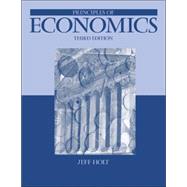Principles of Economics, 3rd Edition, by Jeff Holt is a clear, concise, and economical alternative to the typical textbook. This text includes a built-in study guide that enables students to reinforce concepts and better comprehend the material. The book is spiral bound which allows it to lay flat when open, making it easier for students to work the problems in the study guide. Supplemental materials available for adopting instructors include an Instructor's Manual, Test Bank, and Power Point slides--all prepared by the author.
This text is in use at the following Colleges and Universities:
American International College
Austin Peay State University
Black Hills State University
Cazenovia College
Colorado State University – Pueblo
Davidson County Community College
Eastern Maine Community College
El Camino College
Elizabethtown Community College
Florence Darlington Technical College
Geneva College
Georgia Highlands College
Georgia Southern University
Goldey-Beacom College
Idaho State University
Johnson State College
Malvern Preparatory School
Mesa Community College
Mesabi Range Technical and Community College
Millersville University
Nicolet Area Technical College
Otero Junior College
Palm Beach Atlantic University
Penn State Worthington Scranton
Providence College
Sierra College
Southern Polytechnic State University
Southwestern Oregon Community College
Spokane Community College
St. Gregory’s University
SUNY – Cortland
Thomas University
Trinity College
Tulsa Community College
University of Arkansas Community College at Hope
University of Cincinnati
University of Hartford
University of Massachusetts Dartmouth
University of Montana – Western
Utah Valley State College
Valdosta Technical College
Western Dakota Technical Institute
